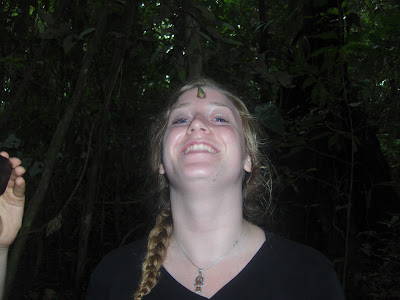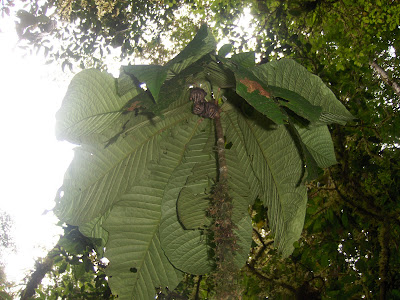Sorry it's been so long, y'all, things have been rather busy lately. In this post, I'm going to relate the story of a trip I took about three weeks ago, so my memories are not quite as vivid as they were right afterwards. For a little bit of context, USFQ was granted a large parcel of land some years back just north of Yasuní National Park in the eastern part of Ecuador for the express purpose of conservation and research. This parcel of land is located on the Tiputini River, thus its name: Tiputini Biodiversity Station (TBS). What makes TBS so incredible is the fact that it is located in arguably the most biodiverse ecosystem on the planet.
The trip began at around 6 a.m. Friday morning, where all of the students going to the station met at the Quito airport. After a surprisingly streamlined trip through airport security and an hour or so of waiting in the terminal, we boarded our plane to Coca. Coca is one of the few large towns in the east of Ecuador, founded by early missionaries and later, after the discovery of large amounts of petroleum in the jungles of the east, maintained by oil companies. Seeing as oil companies write my tuition checks, I will try not to be too harsh on them, but if you are not familiar with the history of Texaco/Cheveron in Ecuador, it warrants some exploration. Texaco was more or less given unrestricted and unregulated access to Ecuador's eastern territories by the dictator General Rodriguez Lara after he came to power in 1972. Texaco, and later Cheveron, neglected to follow standard operating procedures for the disposal of hazardous materials drawn from their wells, and as a consequence, thousands of indigenous people living in the jungles of the oriente have experienced devastating health problems for decades, and their lawsuit against Cheveron (to the tune of $23 billion) is ongoing.
I'll go ahead and get off my soapbox and continue with the story. We landed in Coca, took a bus to a hotel by the Napo river and boarded a long, thin boat for a two hour ride down the river. After a long, relaxing boat ride, we docked at a checkpoint for the entrance to a road into the oriente originally built by an American oil company, but now maintained by REPSOL, an oil company out of Spain. The security at this station was tight, with camouflaged men with assault rifles patrolling the area and photography strictly prohibited. Following a short wait, we embarked on a "ranchera" (an open-air bus) down the road for a good 90 minutes. We finally arrived at where the road crossed the Tiputini river and promptly set sail for another two hour boat ride.
On the Napo River
Me, Chloe, and Alex on the Napo
When, at last, we arrived at the station, we were given a quick briefing on the rules and procedures of the station and then guided to our cabins. After a hearty dinner (the food at Tiputini was some of the best I've had in Ecuador), we retired to our cabins. We all woke up around 6:30 a.m. the next day, as breakfast started at 7 a.m. sharp. Perked up after pancakes and coffee, we were split into three groups to embark on our morning hikes. My group went to the "puentes," which were essentially a series of bridges and platforms right at the top of the jungle canopy. On the walk to the puentes, we observed some congas, otherwise known as bullet ants. Congas are among the biggest species of ants in the world, and their sting is known to cause extreme pain. Just one sting can (and has, on multiple occasions) reduce a grown man to tears. Taking this into account, it is hard to believe that many indigenous groups in the oriente intentionally inflict 20 or more stings on young men as a part of rituals symbolizing the transition to manhood. Candidates are expected to show no reaction to the excruciating pain. The puentes themselves were incredible, but I'll let the pictures speak for themselves. On the way back to camp for lunch we took a roundabout rout (to say the least), but our guide pointed out a type of plant that holds lemon-ants inside small pods at the base of its leaves. Needless to say, we all partook in the consumption of these ants, which, as their name suggests, had a strong citrusy taste.

Our awesome guide, Ramiro, with a giant stick-bug
The Puentes
The highest platform at the Puentes
Ramiro introducing us to the lemon-ants
In the afternoon, we went to "the tower." The tower, like the puentes, is situated high above the canopy and equipped with a telescope for optimal wildlife-viewing. We stayed on top of the tower for a couple of hours chatting and spotting wildlife (toucans, parrots, wooly monkeys, and howler monkeys, just to name a few). We hiked back to the cabins, took a quick rest, and then ate some dinner. After dinner, we were invited to the lab (the largest and most technologically advanced building at the station) to view a slideshow of the various animals that had been captured on film around the station. One of the many research projects currently being executed at the station involves a number of camera traps situated all around the University's territory. These camera traps have captured at least two species never before caught on film in the wild (both are species of wild dog) along with jaguars, black jaguars (otherwise known as panthers), wild pigs, and many other exotic species.
The Tower
One of many camera-traps
The next morning after breakfast, our group travelled to the last of the three spots on the rotation: a large lake known to house anacondas and caimanes. Although we did not see any caimanes or anacondas, we did get a good look at an adorable chick in a nest situated in the vegetation at the edge of the lake. Other significant events from this excursion include: me getting bit where the sun don't shine by a giant mosquito-like insect that is known to carry botfly eggs (pray that I am not infected by these parasites and rendered sterile), and a Wooly Monkey throwing a tree branch at our group.
Canoeing on the lake

This is the little bastard who got to my most tender spot through underwear and pants... Evil

Giant spider on the dock at the lake
In the afternoon, we travelled upriver for a good while to fish for piranhas. We did not succeed in catching any piranhas, supposedly because the river was higher than usual. Instead of taking the boat back to the station, we were invited to put on life vests and simply allow the Tiputini River's strong current to take us back home. Naturally, we all obliged. The float was relaxing for the most part, though it got rather cold after a while and we were all too terrified of
this parasite, known for swimming up poor humans' urethras as they urinate in the water, to relieve ourselves.
After dinner, we split into groups yet again for a night-hike. On this hike we saw two
whip spiders, a giant worm being eaten by ants (the worm must have been 10 inches long and an 1.5 inches in circumference), and what the guide called a "cigar grasshopper" (which apparently doesn't translate very well into english, as I couldn't find a picture online). This grasshopper is apparently the biggest species in the world and lived up to its name, as it was large, fat, and brown.
The next day, we rose bright and early yet again, and repeated the whole traveling process in reverse (boat on the Tiputini River, Ranchera on the REPSOL road, boat on the Napo River, and flight from Coca). We came home tired, behind on our homework, but all very happy to have spent the weekend in one of the most biodiverse places on the planet with new friends (from now on I will have a very positive view of the University of Illinois, for example).
More photos:
This was a really spiky tree
Also good for making unicorn horns
Yes, those are bats under that tent of leaves
Thank God for rubber boots
That enough butterflies for ya?
Cool moth































